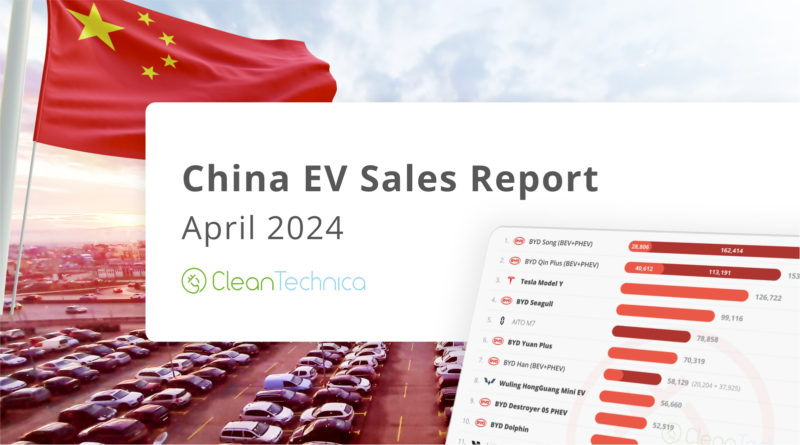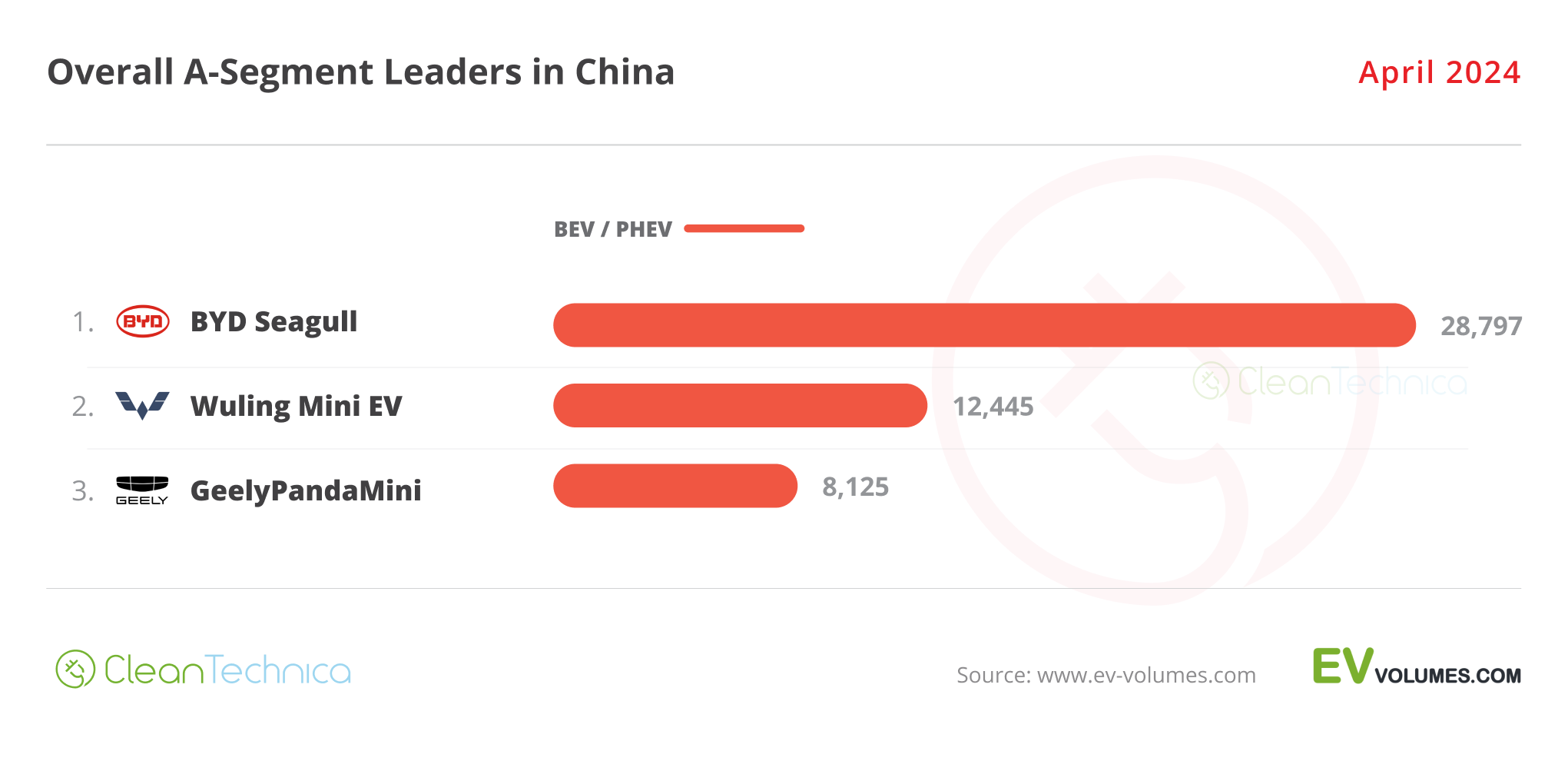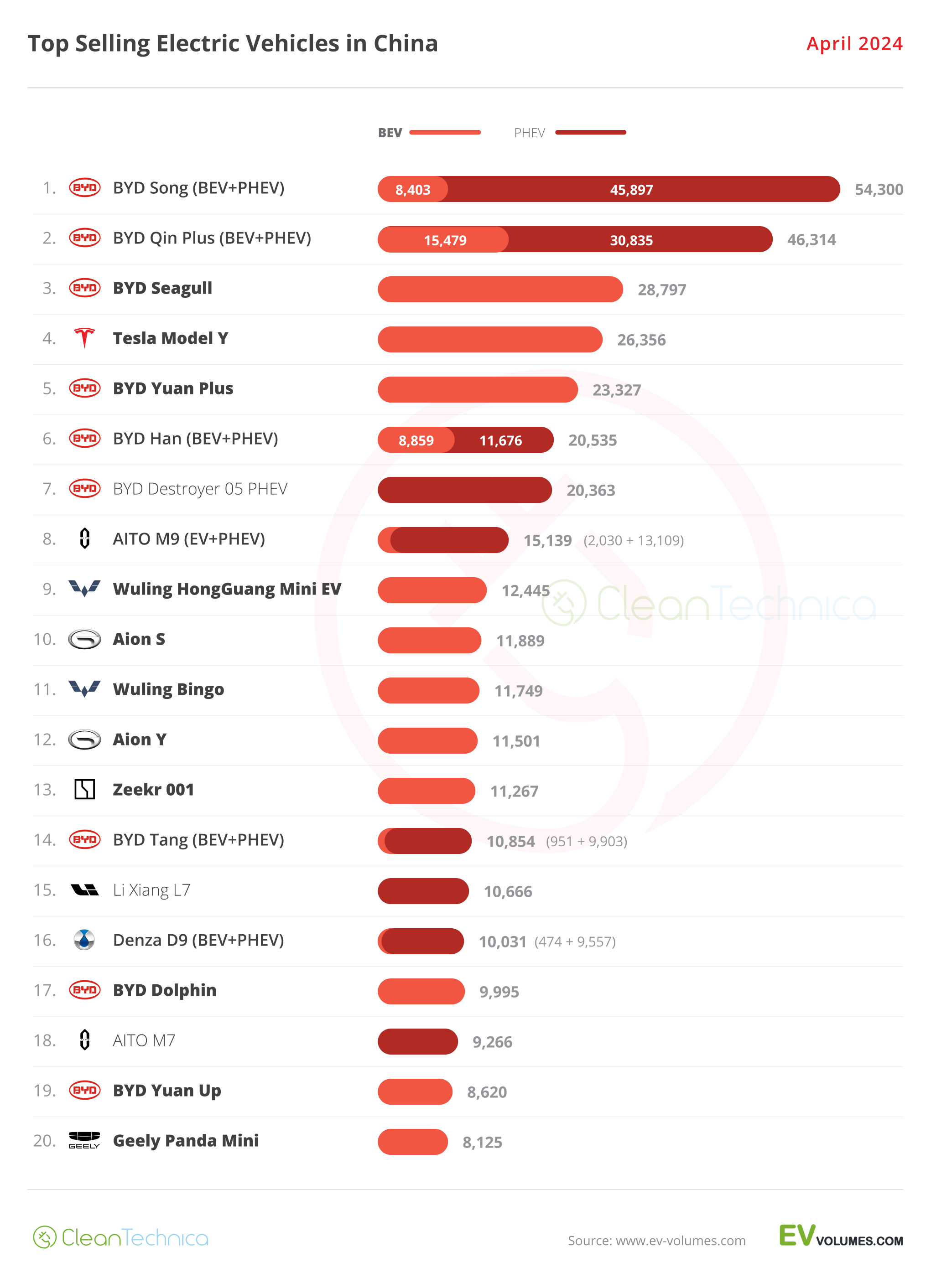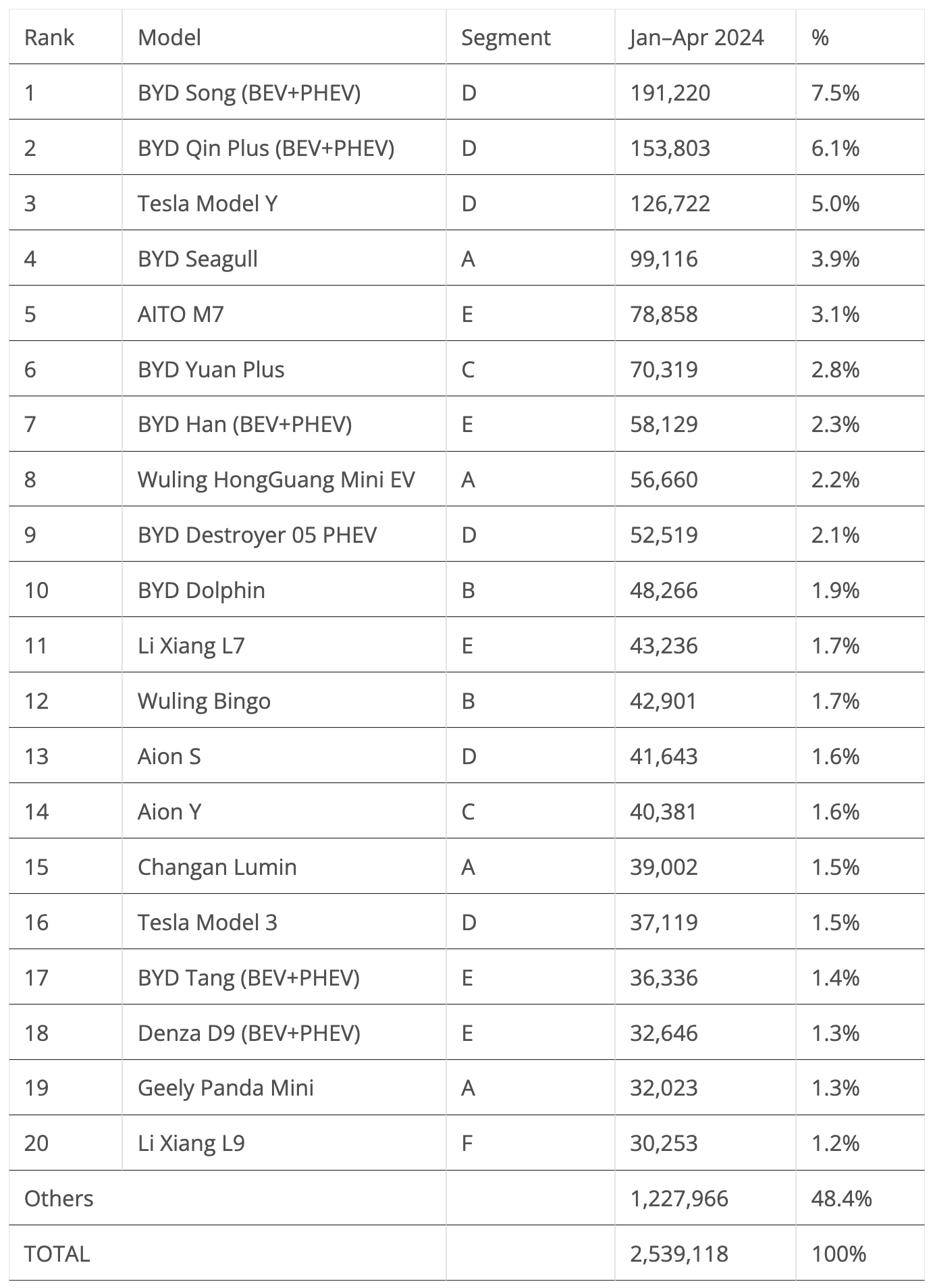44% Plugin Vehicle Market Share In China — April 2024 Sales Report
Plugin vehicles are all the rage in the Chinese auto market, with plugins scoring 703,000 sales (in a 1.6-million-unit overall market). That’s up 27% year over year (YoY).
Looking deeper at the numbers, BEVs were up 10%, while PHEVs did even better, jumping 65% in April. Breaking down plugin sales by powertrain, BEVs had 59% of sales, below this year’s average of 65%, proving the rising popularity of plugin hybrids in this market.
The year-to-date (YTD) tally is around 2.5 million units, a significant rise over the 1.9 million in the same period of 2023.
Share-wise, April saw plugin vehicles hit 44% market share! Full electrics (BEVs) alone accounted for 26% of the country’s auto sales. This pulled the 2024 share also to 40% (26% BEV), and with the market still with plenty of room for growth, the first half of the year should end above 40%. (And maybe above 50% by year end?)
Comparing this result with April 2023, at the time, the plugin share was 35% (24% BEV), while the YTD numbers were at 33% share (23% BEVs), which means that, while BEVs are experiencing moderate growth (23% vs. 26%), the PHEV share is growing faster (10% vs. 14%). This is something to think about….
The podium was 100% plugins and 100% BYD, with the Tesla Model Y being the best selling non-BYD model, in 4th. The best selling ICE model was the Nissan Sylphy, in 5th, with some to 24,000 units sold. The Japanese model was the first of three ICE models in the top 10.
Benefitting from its recent War on ICE, in the Chinese market, BYD placed five six models in the overall top 10! Price cuts from the Shenzhen make are pressuring not only the ICE competition, but also its plugin adversaries….
Looking at the several categories, the A (city car) and D (midsize) segments continue to have 100% PEV podiums, while the C (compact) segment is the only one where ICE vehicles are still a majority. BYD’s compact hatchback is surely needed…
Anyhow, with the exception of the C segment, where the Nissan Sylphy still soldiers on as the sole ICE category leader, BYD is ahead in every other category. The (not so) big surprise comes from the new BYD Yuan Up, which joined the podium in the B segment (subcompacts), with that category now having a full BEV podium.
Another surprise was AITO’s M9 yacht landing in 2nd place in the full size category, surpassing the ICE category leader, and more importantly for the Huawei-backed brand, going above the Li Auto models….
Best Selling EVs — One by One
Regarding last month’s best sellers table, the top 4 best selling models in the overall table exactly mirrored the ones in the EV table — which once again proves the merging process that we are witnessing between the two tables. Here’s more info and commentary on April’s top selling electric models:
#1 — BYD Song (BEV+PHEV)
BYD’s midsize SUV is the uncontested leader in the Chinese automotive market, and the star player retained the leadership position in April, keeping its Qin Plus sibling in the runner-up spot. The midsize SUV scored 54,300 registrations, with 8,403 units belonging to the BEV version. Will the Song continue to rule in the Chinese automotive market? Well, it depends on the competition, especially the internal competition. Currently, the Song only has the recently introduced Song L as internal competition, but the upcoming Sea Lion 07 and the premium car-on-stilts Denza N7 (a car that sits somewhere between the Tesla Model Y and the Zeekr 001) are both also wanting a piece of the pie. This is probably too much competition inside BYD’s midsize SUV portfolio for the Song to continue clocking 50,000 sales/month, a necessary threshold to continue leading the cutthroat Chinese auto market, but thanks to its recent price cuts, the Song is continuing its success story.
#2 — BYD Qin Plus (BEV+PHEV)
Along with the Song, the BYD Qin has been a bread and butter model for the Chinese automaker for a long time. The midsize sedan reached 46,314 registrations in March (15,479 units belonged to the BEV version). This allowed it to be second in the overall market, with the sedan benefitting from being the first pawn launched by BYD in its recent “War on ICE” campaign (aka price cuts). Prices now start at 80,000 CNY ($12,000), and demand is bound to stay high. Despite the strong internal competition — a new, fancier Qin L and a Seal 06 PHEV are said to be launching soon — expect BYD’s lower priced midsize sedan to continue posting strong results at the cost of the competition, EV or ICE, all while keeping its most direct competitors — the Tesla Model 3, Wuling Starlight, and GAC Aion S — at a safe distance.
#3 — BYD Seagull
Things continue to go well for the hatchback model, with the small EV securing another top 5 presence thanks to 28,797 registrations. With part of production now being diverted to export markets, it seems demand for the little Lambo is now at cruising speed in China. The perky EV is now in top 5 territory. Even with its attention now diverted to other geographies, like Latin America and Asia-Pacific, expect the little BYD to continue being part of the BYD pack that populates the Chinese top 10. What about export prospects to Europe? There are talks that the model will be launched in Europe in the second half of the year. Of course, do not expect the low prices in Europe that the Seagull has in China. When the city EV lands, as the Dolphin Mini, European prices will be significantly higher for a number of reasons (tariffs, VAT, etc.), but I wouldn’t be surprised if it started at 17,999€ … which would still be a killer price considering the direct competition is north of 20,000€.
#4 — Tesla Model Y
Tesla’s star model got 26,356 registrations, which allowed it to land in 4th in the overall ranking. It seems the US crossover is at cruising speed in the Chinese market, having lost just 2% of volume YoY in April, keeping volumes at around 25,000–30,000 units a month, peaking at about 45,000 units in the last month of the quarter. While that doesn’t make it the best seller in the market, it allows the Model Y to stay Tesla relevant in the Chinese market — no small feat, considering current market trends (it was the only foreign model in April’s top 20). And this somehow disguises the frosty reception that the refreshed Model 3 had in this market, with the sedan registering just 5,065 units last month, a 62%(!) drop YoY. With this in mind, if i was Tesla, I would be careful refreshing the Model Y … best to do it late, but with purpose, than to play fast and loose….
#5 — BYD Yuan Plus
A big beneficiary of the recent price cuts, the compact crossover returned to the top 5 thanks to 23,327 sales, keeping its most direct rival, the Aion Y (#13 with 11,500 registrations) at a safe distance. With the upcoming launch of the BYD Yuan Up, sales of the Yuan Plus could suffer. The new crossover is not that much smaller (4,32 mt vs. 4,46 mt), but it is significantly cheaper (CNY 97,000 vs. CNY 120,000) AND has a more normal design, especially inside, which might put off some but could be a plus side for others. One thing is certain: the Yuan Up will be another sales success for BYD, even if at the cost of other BYD models, like the Dolphin or the Yuan Plus. Now, about that Seal hatchback….
BYD’s Domination in the Top 20
Looking at the rest of the best seller table, many of the highlights also comes from BYD. The Han flagship sedan returned to form and ended April in 6th, with 20,535 sales. Just below it, the #7 Destroyer 05 broke its personal record for the second month in a row, registering 20,363 units. Overall, there were six BYDs in the top 7 positions. And that’s not all….
The poor showing from the BYD Dolphin, 17th, with just 9,995 units, has a reason. That reason is called the BYD Yuan Up. The value-focused crossover joined the table, in #19, with 8,620 units — in only its second month on the market! Expect the small crossover to jump a few more positions in May (top 10?), but for now, BYD’s new model entry into the table allowed the Shenzhen OEM to have 10 representatives in the top 20!
And this kind of domination is happening in a time where BYD has several potential best selling models (Qin L, Seal 07, Seal 06, Seal hatchback …) getting ready to land. Sure, at this point, these models will likely cannibalize existing BYD models, but they will likely also steal sales from the competition.
Although, one starts to wonder at what point BYD’s new model launch fever will start to get counterproductive…. How much is too much?
 Chip in a few dollars a month to help support independent cleantech coverage that helps to accelerate the cleantech revolution!
Chip in a few dollars a month to help support independent cleantech coverage that helps to accelerate the cleantech revolution!
More Top 20 Notes
Outside the BYD Galaxy, I have a few more notes on the April top 20. The AITO M9 joined the table, jumping to #8, with a record 15,139 sales, 2,030 of them belonging to the BEV version. The flagship AITO is the make’s most recent model, and probably the best of the make so far, so expect the 5.2 meter (205 inch) land yacht to become a frequent presence in the table and a serious contender to the XXL SUV category title.
The Zeekr 001 was 12th, thanks to 11,267 sales, its best result in 16 months, with the flagship model taking full profit from the recent refresh.
A final note on the segment distribution of the top 20: the most represented category is full size models, with 7 models on the table — or more than one third of all models here! Gone are the days when the moniker Chinese EVs rhymed with tiny, cheap, underpowered, tin cans….
Outside the top 20, there are several models worth looking into, like Changan’s new EV brand, called Qiyuan, which had its A05 sedan reach 5,317 sales. There’s NIO’s ET5, which reached 6,710 sales in April, its best score since last August, with the interesting fact that the Touring version (aka station wagon) outsold the sedan version in a 2-to-1 ratio. With the Buick Velite 6 (7,538 sales in April) consistently punching above Buick’s weight, can one say that station wagons are starting to get trendy in China? Discuss.
One of Huawei’s other brands, Luxeed, made in cooperation with Chery, is seeing its S7 full size sedan reach significant volumes. It reached 5,012 units in April. With AITO models going after Li Auto’s full size SUVs, will Huawei’s Luxeed brand also be successful in beating the BYD Han and Zeekr 001?
Also ramping up is Leap Motor’s C10 compact crossover, with the startup’s most recent model having 5,368 sales in April, 4,024 of them belonging to the BEV version. This is Leap Motor’s most important model so far, because not only is it the one set to be the brand’s best seller in China, but also because it is the first one developed from the beginning with overseas markets in mind, and with the recent association with Stellantis now coming to fruition, we can expect this crossover to land on European shores this year, as well as in other markets soon after.
Last, but surely not least, a mention goes out to the Xiaomi SU7 landing in April. It is a car with unbeatable value for money. It is the size of a Tesla Model S, has air suspension, has a 0.195 drag coefficient, has 800-volt architecture, has 74 kWh LFP or 101 NMC batteries with a promise of a 150 kWh version coming later on, and all of this for Tesla Model 3 prices! That is … quite an offer.
No wonder they have already locked in some 100,000 orders. Not reservations, actual orders. So, it is not surprising that the SU7 landed with a significant 7,058 registrations, and aims to achieve some 100,000 deliveries this year alone!
With the electronics giant preparing the SUV version of the SU7 for 2025, and a smaller, lower-cost model set to land in 2026, Xiaomi could be a disruptive force on the market.
The 20 Best Selling Electric Vehicles in China — January–April 2024
Looking at the 2024 ranking, there’s nothing new in the podium positions, with the podium bearers BYD Song, BYD Qin Plus, and Tesla Model Y safely in their positions.
Due to a bad month for the AITO M7 (#18 in April), the 4th placed BYD Seagull distanced itself from the full size SUV, while the #6 BYD Yuan Plus now has the AITO model in shooting range.
The first position change happened below them, with the BYD Han jumping two positions, into 7th, while its smaller sibling, the Destroyer 05, was also up, in this case to 9th.
On the second half of the table, both Aion models, the S and Y, and the Wuling Bingo benefitted from slow months from the Changan Lumin (6,890 units in April) and Tesla Model 3 (5,065 units) to jump two positions each. The small hatchback is now in 12th, while Aion’s sedan is now 13th and the crossover-MPV mashup is 14th.
With the Tesla Model 3 now #16 and no other foreign model close to the top 20, it is becoming increasingly possible that, by the end of the year, the Tesla Model Y could be the only foreign representative among China’s 20 best selling EVs.
Regarding the lower positions on the table, the BYD takeover continued, with the Denza D9 MPV climbing two spots on the chart to #18.
Finally, more than one third of the models on the table were either crossovers or SUVs, with the eight representatives on the table providing proof of the popularity of these body types.
Changes in the Overall Brand Ranking
In April, the top three positions mirrored the 2023 full year ranking, with BYD on top followed by Volkswagen and Toyota. The dynamics are quite different, though. BYD (240,000 sales) grew 31% YoY, while #2 Volkswagen (136,000 sales) was down by an awful 22% and Toyota (101,000 sales) was even worse, falling off a cliff by 32%. So, while the first place automaker is still rising fast, the other two are losing significant ground in a fast changing market.
Confirming the domestic takeover, #4 Geely (79,000 sales) had a 31% growth rate, mirroring BYD’s growth rate. On the other hand, #5 Honda, the 4th best selling brand in 2023, had 77,000 sales, a 19% drop YoY.
Add this to the fact that #14 Tesla is following the downward trend of foreign OEMs, having dropped 21% YoY in April, and the fact that the only brands in the overall top 20 to grow more than 10% were domestics (BYD, Geely, Chery, AITO, and Jetour), and the prospects for foreign makes looks pretty grim right now.
The only foreign brand in the top 20 to grow in sales was #6 Audi, which was up by … 1%. On the other hand, and looking below the top 20, there are foreign brands that are basically being wiped off the table, like Cadillac, down 50% YoY, Chevrolet, down 78%, Citroen (-50% YoY), Skoda (-55%), and Infinity (-62%).
Auto Brands Selling the Most Electric Vehicles in China
Looking at the auto brand ranking, there’s no major news. BYD (29.8%, up from 29.3%) tightened its grip on its leadership position, and there’s really no way to see this domination ending anytime soon.
Things get more interesting below, though. Due to sales bleeding from #2 Tesla (6.5%, down from 7.1%) and #3 Wuling (5.3%, down from 5.8% — SAIC’s low cost brand is one of BYD’s War on ICE victims), both brands have seen the competition getting closer.
#4 Geely also suffered from the recent BYD price cuts, but because it has a broader lineup, it has seen its share drop only slightly, from 4.7% in March to 4.6% at the end of April. The Chinese brand is now less than 1% below the 3rd position and less that 2% share from #2 Tesla. Will the upcoming Geely Galaxy E5 allow the Taizhou brand to reach the podium? Or maybe even go after the #2 spot? Being a compact crossover, it should remain immune to the current Xiaomi SU7 black hole effect….
Due to the surprisingly good result of the M9, for once, #5 AITO (4.4%) resisted the other black hole effect in the Chinese market, BYD. The startup brand lineup is still too small. One bad month from the M7 & M9 models and things go south quite fast. Fortunately, the refresh of the currently moribund M5 midsize SUV is coming and could provide a little more breathing room for AITO’s lineup.
Finally, Li Auto, despite also losing share, contained its losses (4.2% now vs. 4.3% in March). With the recent launch of the L6 midsize SUV, its cheapest to date, we could see it surpass AITO soon and return to the top 5.
Auto Groups Selling the Most Electric Vehicles in China
Looking at OEMs/automotive groups/auto alliances, BYD Group is comfortably leading, with 31.9% share of the market, a 0.7% gain in April. That increase in share was thanks to the strong result of the namesake brand, but also thanks to good results from its premium branches, Denza, Fang Cheng Bao, and Yangwang. At this moment, it seems BYD has its domestic market domination assured, replicating what Tesla is doing in the USA … and Volkswagen Group should have been doing in Europe.
Geely–Volvo is a distant runner-up, with 8.4% share, having gained a little bit of ground over #3 SAIC (8%). Although, one should highlight that both lost share last month, with both OEMs being hit by BYD’s recent price war.
#4 Tesla (6.5%, down from 7.1%) now has #5 Changan looking to reach the 4th position, but Changan itself cannot be too happy with its performance. Despite a good result from its new Qiyuan brand, it also lost share (6.5%, down 0.2%) in the current price war blood bath.
Have a tip for CleanTechnica? Want to advertise? Want to suggest a guest for our CleanTech Talk podcast? Contact us here.
Latest CleanTechnica.TV Videos

CleanTechnica uses affiliate links. See our policy here.













